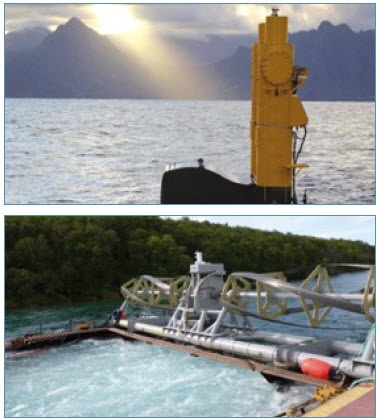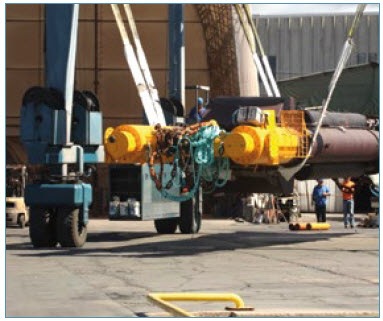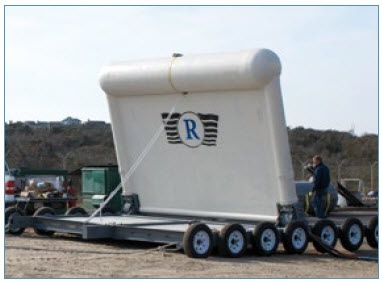UNITED STATES OF AMERICA
TECHNOLOGY DEMONSTRATION
OPERATIONAL PROJECTS
Northwest Energy Innovations: With support from DOE and the U.S. Navy, a prototype wave energy device advanced successfully from initial concept to grid-connected, open-sea pilot testing in June 2015. The device, called Azura, was launched and installed in a 30-meter test berth at the Navy’s WETS in Kaneohe Bay, on the island of Oahu, Hawaii. NWEI designed the Azura in a unique way to extract power from both the vertical and horizontal motions of waves to maximize energy capture. This pilot testing is now giving U.S. researchers the opportunity to monitor and evaluate the performance of the third-party-verified and grid-connected device in the open-ocean for the duration of one year. The primary objectives of this test are to use the data collected to optimize energy capture, and to validate and refine existing cost and performance models.
|
The RivGen® Power System demonstration project provided power to Igiugig. Connecting the small community to the grid and decreasing the use of high-cost diesel fuel for electric power generation helps lower electricity costs for consumers since all fuel must either be barged or flown in to the rural village, and that cost is passed on to rate payers. This project was successfully decommissioned after two months of operation, and numerical models and deployment data are being analysed and validated to evaluate the improvements from implementing advanced control systems. ORPC’s advanced control systems are being developed in collaboration with the University of Washington, Maine Technology Institute, and NREL with support from the DOE Water Power Program. |
|
PLANNED DEPLOYMENTS
|
Northwest Energy Innovations (NWEI): NWEI’s Azura™ With funding from the DOE Water Power Program, NWEI will design, fabricate, and test a full scale Azura™ wave energy device to reduce the LCOE and demonstrate commercial viability at a deep water berth at U.S. Navy’s WETS in Hawaii. The proposed testing will allow NWEI and its team to determine the energy capture matrix of a full scale device, resulting in a more accurate assessment of LCOE.
|
|
|
|
Ocean Energy (OE) USA: This project will leverage lessons learned from three years of extensive scale model testing in Galway Bay, Ireland that identified design opportunities to lower the cost of electricity and make these design improvements to the OE Buoy technology for a full scale deployment at WETS. The open water demonstration of the buoy will gather baseline performance data, gain operational experience, and identify further cost reduction opportunities for oscillating water column devices. Comprehensive LCOE validation data will also be generated during deployment in 2017. |
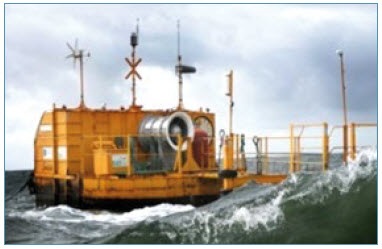 |
Resolute Marine Energy:
The Water Power Program is supporting Resolute Marine Energy to develop an intelligent feedback control algorithm for their next-generation device, SurgeWECTM. The control system will be validated in Resolute’s development centre on a full scale SurgeWECTM and, upon completion, will be integrated into Resolute’s project planned for deployment off the coast of Camp Rilea, Oregon.
|
Fred Olsen: Its hull design provides buoyancy and water displacement and has a low vertical profile, which reduces the impact of sea forces during more aggressive sea states. BOLT Lifesaver has on-board energy storage that enables autonomous and continuous operation through varying sea states.
|
|
|
|
Columbia Power Technologies: With funding from the Water Power Program, the StingRAY has innovated a direct-drive permanent magnet generator for Power Take-Off which reduces the number of moving parts, compared to gearboxes, integrated with a composite hull structure for the generator’s “nacelle.” The composite structure helps to increase the strength and longevity of the device. The deployment at WETS, supported by the U.S. Navy, will include StingRAY utility scale design and certificati on, performance and efficiency validation, and design and testing of the structural components. |
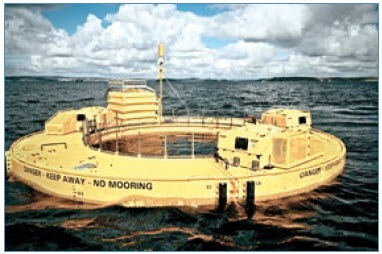 |

